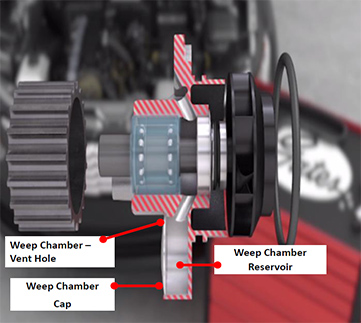Though small, the water pump weep hole chamber cap is an essential water pump component. Because this cap looks very similar to a core plug used on an engine, many mechanics assume the former serves the same purpose as the latter. We’ll explain that this belief is based on a misunderstanding.
The function of the engine core plug
Engine core plugs (also called freeze plugs, frost plugs, or engine block expansion plugs) are used to cover the sandcasting core holes found on water-cooled, internal combustion engines. Sandcasting core holes are designed into the engine casting to support internal sand forms, and they aid the removal of the sand after the casting has cooled. During the casting process, these sand cores form internal cavities or coolant passages within the engine block or cylinder head, allowing coolant to circulate when the engine is in operation.
Core plugs are generally thin metal cups press-fitted into the sandcasting holes, yet they can be made of rubber or other materials as well. Installing core plugs into the casting holes enables coolant to be retained in a sealed environment. Moreover, core plugs help protect the engine’s metal casting when temperatures drop. In a vehicle that hasn’t been serviced regularly, the coolant might be weak or even entirely absent. When the water subsequently freezes, the core plugs will be pushed out of the engine, thus allowing the coolant to expand externally and preventing engine damage (otherwise, the metal of the engine would crack).
An engine core plug
The introduction of the weep chamber reservoir
To explain the function of the water pump weep hole chamber cap, and how it differs from that of the engine core plug, we first need to talk a little about the weep chamber reservoir.
The water pump’s internal mechanical seal seals the shaft towards the cooling circuit, thus protecting the bearings by preventing coolant from passing into the bearing assembly. All mechanically driven water pumps have a weep hole that
might leak a little in the beginning. With
a new water pump, it takes about ten minutes of operation for the dynamic seal to properly seal itself. During that break-in period, small drips are to be expected. To make sure mechanics would not think anything was the matter with their newly installed water pump (many water pumps used to be changed prematurely because they were thought to be leaking), carmakers introduced the
weep chamber reservoir to hide seepage from the weep hole. As the mechanical seal is formed, excess coolant that travels down the weep hole will collect in this reservoir. The collected coolant will evaporate when the engine reaches its normal operating temperature. However, not all modern water pumps have this weep chamber. Sometimes the engine design does not allow the water pump housing to have this feature.

Image 3: The weep chamber
The function of the weep hole chamber cap
As you can see on image 3, the weep hole chamber cap’s role is to cover the weep hole chamber. Above the cover there is a weep chamber vent hole. This allows excess coolant to escape from the system if the mechanical seal has not formed correctly, which is usually due to coolant contamination.
The weep hole chamber cap and its vent hole
If the coolant system contains contamination, such as rust or sediment, these particles can become lodged between the mechanical seal surface, causing leakage paths. Then a continuous flow of coolant will be seen around the weep chamber vent hole, leaving a discolored water mark on or around the water pump body.
Discoloration where contaminated coolant has come out of the vent hole
So, the caps used on water pumps act as a cover to retain coolant in the weep chamber reservoir; they are not designed to serve as a freeze plug – unlike engine core plugs.